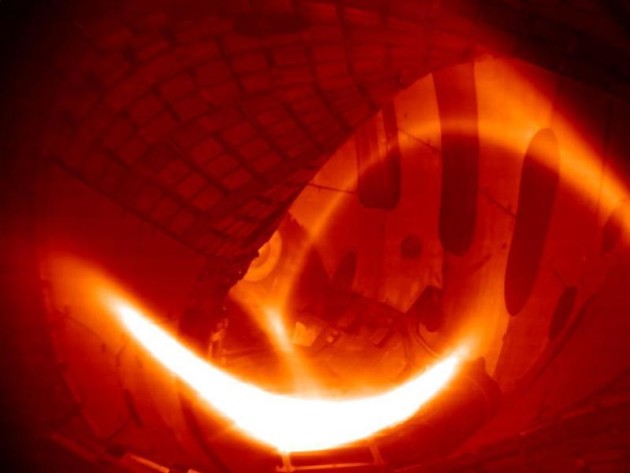
Hydrogen plasma was produced for the first time today in Germany’s Wendelstein 7-X fusion device, which has been called the “reactor designed in hell” as well as the “pretzel that could save Planet Earth.”
The Wendelstein 7-X was built at the Max Planck Institute of Plasma Physics in Greifswald at a cost of €1 billion ($1.1 billion). The device, known as a stellarator, is built to contain superheated plasma inside a magnetic chamber with a tangled, pretzel-like configuration.
Physicists at the institute are hoping that the crazy-looking design will keep the plasma stable for extended periods within the magnetic field. That’s been an issue for plasma chambers with a more typical doughnut-like design, which are called tokamaks. (“Tokamak” is the Russian acronym for a toroidal chamber with an axial magnetic field.)
The world’s biggest tokamak, the ITER experimental reactor in France, is currently under construction and not expected to go into operation until the mid-2020s at the earliest. In the meantime, scientists will be studying whether the Wendelstein design could serve as a viable alternative for future power plants.
The Wendelstein 7-X stellarator went into operation in December, and since then it’s produced more than 300 discharges with helium. Those discharges served primarily to clean the plasma vessel, the Max Planck Institute explained in a news release.
Today, German Chancellor Angela Merkel pressed a button to turn on a 2-megawatt pulse of microwave heating inside the device. That transformed a tiny bit of hydrogen gas into hot but diffuse hydrogen plasma, marking the official beginning of scientific operations.
“With a temperature of 80 million degrees [Celsius] and a lifetime of a quarter of a second, the device’s first hydrogen plasma has completely lived up to our expectations,” said Hans-Stephan Bosch, division head of the Wendelstein 7-X project.
The tempo of the experiments will increase over the months and years to come. In about four years, scientists are aiming to produce plasma discharges that can last 30 minutes at the full heating power of 20 megawatts.
The researchers don’t expect this stellarator to achieve a net gain in energy. However, the engineering data could blaze a trail for future reactors that generate cheap, abundant electricity from hydrogen isotopes.
For an overview on fusion research, check out Alan Boyle’s report in Science News.



